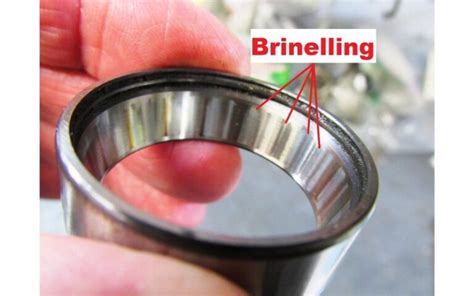Brinelling: The Silent Bearing Destroyer
Brinelling, a common and often overlooked failure mode in rolling-element bearings, can lead to catastrophic consequences. Understanding and preventing brinelling is critical for optimal bearing performance and equipment reliability.
Understanding Brinelling
Brinelling occurs when a bearing's rolling elements (balls or rollers) indent the raceways due to excessive static loads or impact forces. These indentations, known as brinells, weaken the raceways and reduce bearing load capacity, leading to premature failure.
Brinelling is a insidious failure mode as it can occur gradually over time, often without noticeable symptoms. By the time it becomes evident, the bearing may have sustained significant damage, requiring costly repairs or replacement.

Causes of Brinelling
The primary cause of brinelling is excessive static loads. When a bearing is subjected to a static load that exceeds its designed capacity, the rolling elements can embed into the raceways. Impact forces, such as shock loads or misalignment, can also induce brinelling.
Consequences of Brinelling
Brinelling has severe consequences for bearing performance and equipment reliability. Indented raceways can cause:

- Reduced load capacity
- Increased noise and vibration
- Premature bearing failure
- Damage to mating components, such as shafts and housings
Prevention and Detection
Preventing brinelling is crucial for extending bearing life and ensuring reliable operation. Here are key measures to consider:

-
Avoid excessive static loads: Ensure bearings are sized and installed to handle the anticipated loads.
-
Minimize impact forces: Use shock absorbers, vibration isolators, and proper alignment to reduce impact forces.
-
Use hardened raceways: Bearings with hardened raceways have increased resistance to brinelling.
-
Lubricate bearings adequately: Proper lubrication reduces friction and helps prevent metal-to-metal contact.
-
Monitor bearings regularly: Inspect bearings for brinelling using vibration analysis, thermal imaging, or other diagnostic techniques.
Common Mistakes to Avoid
-
Ignoring static loads: Static loads are often overlooked in bearing selection, but they can have a significant impact on brinelling.
-
Overloading bearings: Exceeding a bearing's load capacity, even momentarily, can lead to brinelling.
-
Improper installation: Misalignment or incorrect mounting can induce impact forces and brinelling.
-
Insufficient lubrication: Inadequate lubrication can lead to metal-to-metal contact and brinelling.
-
Neglecting maintenance: Regular inspection and maintenance are essential for detecting and preventing brinelling before it causes serious damage.
Comparison of Pros and Cons
Brinelling has several negative consequences, but some potential benefits include:
-
Early detection: Brinelling can be a sign of excessive loading or impact forces, helping identify underlying issues.
-
Preventive maintenance: Prompt attention to brinelling can prevent catastrophic bearing failure.
-
Cost savings: Avoiding premature bearing failure can save significant repair and downtime costs.
FAQs
What is the difference between brinelling and spalling?
Both brinelling and spalling are bearing failure modes that involve indentations or cracks in the raceways. However, brinelling is caused by excessive static loads or impact forces, while spalling is typically caused by fatigue or wear.
How do I know if my bearing has brinelling?
Symptoms of brinelling include increased noise and vibration, reduced load capacity, and premature bearing failure. Visual inspection can reveal brinells as indentations in the raceways.
What are the consequences of brinelling?
Brinelling weakens the bearing and reduces its load capacity. It can lead to premature failure, damage to mating components, and increased downtime.
Interesting Stories
Story 1
A truck driver ignored a warning light indicating an overloaded trailer. As he drove down a bumpy road, the excessive static load caused brinelling in the rear axle bearings. The bearings failed catastrophically, leading to a costly breakdown and delayed delivery.
Story 2
A factory worker used a hammer to install a new bearing. The impact force caused brinells in the raceways, which reduced the bearing's life by over 50%. The factory experienced repeated bearing failures until the root cause was identified.
Story 3
During a maintenance inspection, a technician noticed brinelling in a bearing used in a critical pump. He took immediate action to replace the bearing and investigate the source of the excessive static load. As a result, a potential pump failure and plant shutdown were averted.
Conclusion
Brinelling is a preventable bearing failure mode that can have severe consequences for equipment reliability and safety. By understanding the causes and prevention methods, and by monitoring bearings regularly, industries can extend bearing life, minimize downtime, and ensure optimal equipment performance.
Additional Resources
Tables
| Cause |
Effect |
| Excessive static loads |
Indentation of raceways |
| Impact forces |
Localized plastic deformation |
| Hardened raceways |
Increased resistance to brinelling |
| Prevention Method |
Benefits |
| Avoid excessive static loads |
Extends bearing life |
| Minimize impact forces |
Prevents brinelling |
| Use hardened raceways |
Enhances durability |
| Lubricate bearings adequately |
Reduces friction and wear |
| Monitor bearings regularly |
Detects brinelling early |
| Mistake |
Consequence |
| Ignoring static loads |
Overloading and brinelling |
| Overloading bearings |
Premature failure |
| Improper installation |
Impact forces and brinelling |
| Insufficient lubrication |
Metal-to-metal contact and brinelling |
| Neglecting maintenance |
Undetected brinelling and catastrophic failure |
